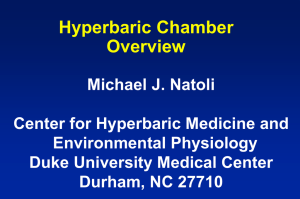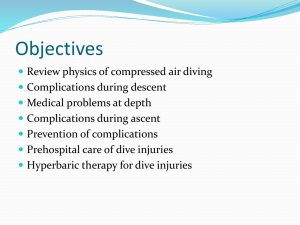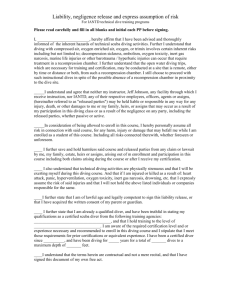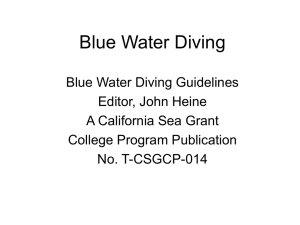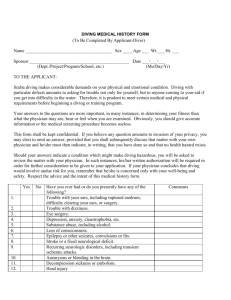Abstract
advertisement
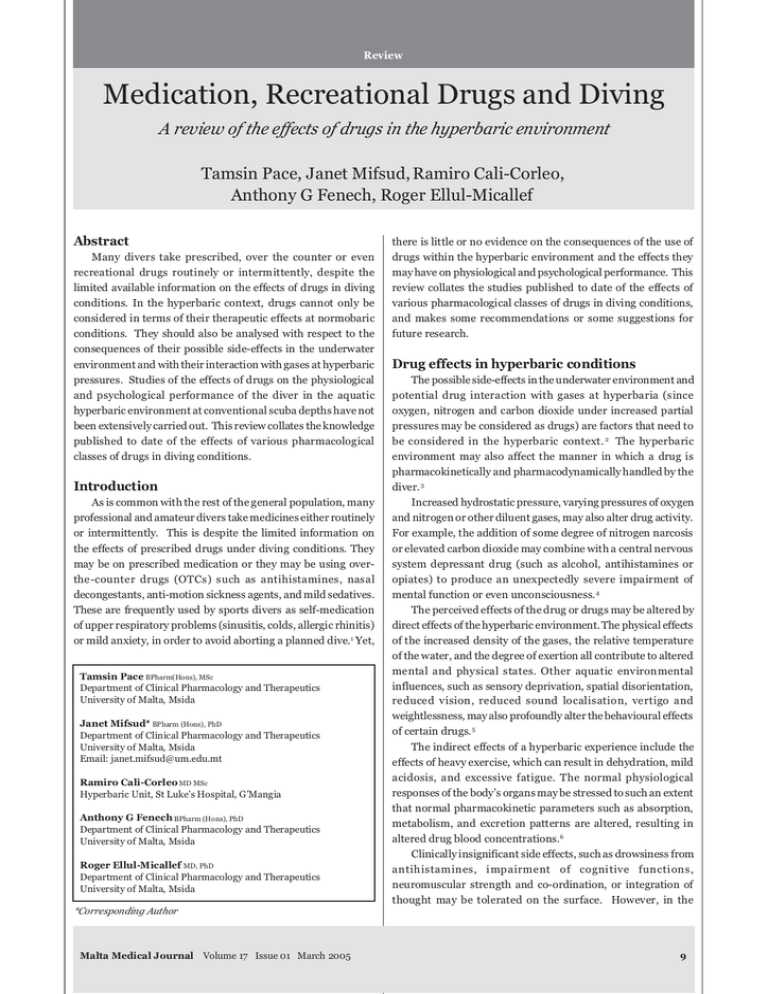
Review Medication, Recreational Drugs and Diving A review of the effects of drugs in the hyperbaric environment Tamsin Pace, Janet Mifsud, Ramiro Cali-Corleo, Anthony G Fenech, Roger Ellul-Micallef Abstract Many divers take prescribed, over the counter or even recreational drugs routinely or intermittently, despite the limited available information on the effects of drugs in diving conditions. In the hyperbaric context, drugs cannot only be considered in terms of their therapeutic effects at normobaric conditions. They should also be analysed with respect to the consequences of their possible side-effects in the underwater environment and with their interaction with gases at hyperbaric pressures. Studies of the effects of drugs on the physiological and psychological performance of the diver in the aquatic hyperbaric environment at conventional scuba depths have not been extensively carried out. This review collates the knowledge published to date of the effects of various pharmacological classes of drugs in diving conditions. Introduction As is common with the rest of the general population, many professional and amateur divers take medicines either routinely or intermittently. This is despite the limited information on the effects of prescribed drugs under diving conditions. They may be on prescribed medication or they may be using overthe-counter drugs (OTCs) such as antihistamines, nasal decongestants, anti-motion sickness agents, and mild sedatives. These are frequently used by sports divers as self-medication of upper respiratory problems (sinusitis, colds, allergic rhinitis) or mild anxiety, in order to avoid aborting a planned dive.1 Yet, Tamsin Pace BPharm(Hons), MSc Department of Clinical Pharmacology and Therapeutics University of Malta, Msida Janet Mifsud* BPharm (Hons), PhD Department of Clinical Pharmacology and Therapeutics University of Malta, Msida Email: janet.mifsud@um.edu.mt Ramiro Cali-Corleo MD MSc Hyperbaric Unit, St Luke’s Hospital, G’Mangia Anthony G Fenech BPharm (Hons), PhD Department of Clinical Pharmacology and Therapeutics University of Malta, Msida Roger Ellul-Micallef MD, PhD Department of Clinical Pharmacology and Therapeutics University of Malta, Msida there is little or no evidence on the consequences of the use of drugs within the hyperbaric environment and the effects they may have on physiological and psychological performance. This review collates the studies published to date of the effects of various pharmacological classes of drugs in diving conditions, and makes some recommendations or some suggestions for future research. Drug effects in hyperbaric conditions The possible side-effects in the underwater environment and potential drug interaction with gases at hyperbaria (since oxygen, nitrogen and carbon dioxide under increased partial pressures may be considered as drugs) are factors that need to be considered in the hyperbaric context. 2 The hyperbaric environment may also affect the manner in which a drug is pharmacokinetically and pharmacodynamically handled by the diver. 3 Increased hydrostatic pressure, varying pressures of oxygen and nitrogen or other diluent gases, may also alter drug activity. For example, the addition of some degree of nitrogen narcosis or elevated carbon dioxide may combine with a central nervous system depressant drug (such as alcohol, antihistamines or opiates) to produce an unexpectedly severe impairment of mental function or even unconsciousness. 4 The perceived effects of the drug or drugs may be altered by direct effects of the hyperbaric environment. The physical effects of the increased density of the gases, the relative temperature of the water, and the degree of exertion all contribute to altered mental and physical states. Other aquatic environmental influences, such as sensory deprivation, spatial disorientation, reduced vision, reduced sound localisation, vertigo and weightlessness, may also profoundly alter the behavioural effects of certain drugs. 5 The indirect effects of a hyperbaric experience include the effects of heavy exercise, which can result in dehydration, mild acidosis, and excessive fatigue. The normal physiological responses of the body’s organs may be stressed to such an extent that normal pharmacokinetic parameters such as absorption, metabolism, and excretion patterns are altered, resulting in altered drug blood concentrations.6 Clinically insignificant side effects, such as drowsiness from antihistamines, impairment of cognitive functions, neuromuscular strength and co-ordination, or integration of thought may be tolerated on the surface. However, in the *Corresponding Author Malta Medical Journal Volume 17 Issue 01 March 2005 9 hyperbaric environment, the side effects may become significant and lead to some cases to serious morbidity or mortality. Cognitive side effects, in particular those which may influence concentration, visual acuity and speed of perception, and reaction, may also be hazardous in a hyperbaric environment. 5 Currently, there is no basis for predicting changes in drug pharmacokinetics or pharmacodynamics in the hyperbaric environment.7 The side-effects of drugs which affect specific body systems and which may be important in the diver are outlined in Table 1. The areas of most concern in diving are the effects on the central and autonomic nervous system. Studies have been mainly around the neurobehavioural effects of drugs under pressure, but other effects such as the production of cardiac arrythmias or aggravation of oxygen toxicity may be equally important. Prophylatic drugs in diving Often, divers may seek drug therapy which will allow them to go for a dive when they might otherwise be unfit to do so. The most common use of drugs is to prevent barotrauma of the middle ear or sinuses. Both topical and systemic Table 1: Common drug side effects in various body systems that may be significant in the hyperbaric environment.7, 11, 17 Body system Neurological Cardiovascular Associated side effects Headache, dizziness, acute psychosis, tinnitus, tremor, extrapyramidal symptoms, parasthesiae, peripheral neuropathy Tachycardia, bradycardia, arrhythmias, postural hypotension, chest pain, oedema Haematological Anaemia, thrombocytopaenia, neutropaenia, coagulopathy Gastrointestinal Nausea, vomiting, abdominal cramps, dyspepsia, diarrhoea, deranged liver function, hepatic failure Renal Renal failure, electrolyte disturbances, disturbances of micturition Musculoskeletal system Myalgia, arthralgia, fatigue Dermatological Pruritus, rash, photosensitivity Ophthalmic Glaucoma, photophobia, blurred vision, scintillation 10 vasoconstrictors are employed in order to shrink nasopharyngeal mucosa to allow pressure equalisation through sinus ostia or eustachian tubes.8 However, too often, the drugs are used to overcome incorrect diving techniques that could lead to barotrauma, upper respiratory tract infections or allergies. Rebound congestion with topical vasoconstrictors may lead to barotrauma of ascent or descent problems later in the dive. Pseudophedrine is the most commonly used vasoconstrictor.9 Drugs have also been used to prevent or reduce the effects of raised partial pressures of diving gases. Anaesthetics, for example, have been studied in order to determine whether they can help overcome nitrogen narcosis and in the amelioration of High Pressure Nervous Syndrome (HPNS).10 Diazepam has been used to prevent or treat the convulsions of oxygen toxicity.4 Research around the use of drugs to try to prevent or minimise decompression sickness (DCS) has been reported. Aspirin may potentially prevent DCS by inhibiting platelet aggregation induced by intravascular bubbles.11 Aspirin may also be used by divers to prevent pain associated with carbon dioxide headaches commonly attributed to hard work or inappropriate breathing technique underwater. 12 Possible serious haemorrhagic effects in the inner ear, barotrauma or spinal DCS limit its clinical use. It may also mask mild symptoms of DCS, through its anti-inflammatory effect, when doses greater than 1000 mg are given. Drug therapy of concurrent illness and diving Several individuals take long-term medication for the treatment of a chronic disease. Very often divers are not made aware of the limitations such medication places on his/her diving activity. The following section reviews drugs in several pharmacological classes and their possible interaction with the hyperbaric environment. Drugs acting on the central nervous system and diving Drugs that act on the central nervous system (CNS) are summarised in Table 2. The common concomitant effects of stimulants may be harmful to a diver, for they produce anxiety, euphoria, dizziness, increased rates of total body metabolism through both oxygen and glucose consumption, and increased respiratory and cardiovascular function. 3 Alteration of vasoactivity in the periphery interferes with heat-conserving mechanisms and makes the diver more susceptible to immersion hypothermia. Hypnotics and anxiolytics such as benzodiazepines, antihistamines, and antipsychotics may induce fatigue, drowsiness, and muscular weakness. An irrational decision or a moment’s lapse of consciousness in the water can lead to drowning. Their use before a dive may cause nitrogen narcosis to manifest itself at greater depths.13 Overall, sedating medications should be avoided when diving because they can impair alertness and judgement, especially at depths beyond 20 to 30 metres where inert gas narcosis may compound the diver’s cognitive impairment.12 Malta Medical Journal Volume 17 Issue 01 March 2005 Cardiovascular drugs and diving Drugs affecting the respiratory system It is recommended that patients with heart disease and taking heart medication should not dive due to the effects of hyperbaric pressure on cardiac function, namely bradycardia and slowed conduction (see Table 3).10 The use of certain antihypertensives such as beta-adrenergic blockers and diuretics, is also a contraindication to diving, as some of these agents reduce exercise tolerance, and, therefore, place the diver at increased risk for overexertion.14 Respiratory agents affect the gas exchange and blood flow in the upper airways and lungs (see Table 4). Evidence about diving and asthma is conflicting. 15 A wide variety of prescription and OTC oral decongestants are available and frequently used by both sport and commercial divers. Although these drugs appear to be reasonably safe on the surface, those that have a sedating antihistaminic component will produce lack of alertness, fatigue and drowsiness. 8 These drugs may have a Table 2: Drugs acting on the CNS and their possible affects on diving Therapeutic class Examples Pharmacological effects Comments Analgesics Acetylsalicylic acid Paracetamol Non-steroidal anti-inflammatory drugs Anti-inflammatory; analgesia; antipyretic Aspirin and paracetamol have been shown to be relatively safe for use in hyperbaric conditions. Narcotic-related analgesics have sedative effects. They may decrease mental performance and may combine with inert gas narcosis to produce CNS depression. 12 Anxiolytics Benzodiazepines Relieve anxiety; depress CNS Diazepam has been used to depths of 50m without any side effects. However, anxiolytics generally cause drowsiness, lethargy, and confusion and hypotension, that could be fatal in the water. A shortacting benzodiazepine might be considered for insomnia after a long saturation dive. 13 Hypnotics Barbiturates Depress CNS and induce sleep Safe diving requires an alert, responsive individual, therefore, these drugs are generally contraindicated for divers. 15 Antipsychotics Phenothiazines Butyrophenones Relieve anxiety and thought disturbances These drugs cause sedation, hypothermia, hypotension, reduction of seizure threshold, cardiac arrythmias and are an absolute contra-indication to diving. 15 Antidepressants Tricyclic Psychostimulants; Antidepressants CNS stimulants; Monoamine-Oxidase Anticholinergic Inhibitors Tricyclics can cause dry mouth, blurred vision, tachycardia and cardiac arrythmias. Monamine-oxidase inhibitors have been shown to interact synergistically with high nitrogen pressures. 16 CNS Stimulants Amphetamines Increase alertness; inhibit fatigue; suppress appetite; mood elevation These cause dizziness, excessive sweating, euphoria, anxiety and panic. Amphetamines have been shown to interact synergistically with increased pressure of air at sea pressures of 2 bar. These drugs are contraindicated in diving. 12 Antiemetics Phenothiazines Anticholinergics Antihistamines Relieve nausea and vomiting Antihistamines are the only indicated drugs for divers for treating motion sickness, although drowsiness may cause decreased cognitive abilities. No significant effects using transdermal scopolamine have been noted. 19 Malta Medical Journal Volume 17 Issue 01 March 2005 11 greater effect on the CNS in the presence of fatigue, use of alcohol or illicit drugs, and increased nitrogen pressure.3 In general, topical decongestants have a reduced effect after repeated use, and a rebound phenomenon that following peak effect may produce reverse ear squeeze during ascent. Anti-microbials and diving The underlying indication for which an antimicrobial has been prescribed needs to be assessed and it may be the basis for temporarily restricting a diver’s underwater activities (see Table 5). Use of antimicrobials is not an absolute contraindication to diving; nevertheless, after an antibiotic is administered for the first dose, regardless of previous exposure to the antibiotic, the diver should not enter the hyperbaric environment for 4 – 6 hours in order to ensure that an allergic response will not develop while the diver is under pressure.11 Topical antifungals are essentially non-toxic and non-sensitising. The use of anthelmintics is a contraindication to diving, for these drugs often produce side effects and adverse reactions that may be confused with the signs and symptoms of decompression sickness.16 Other drugs and diving The effects of other drugs, including ophthalmic preparations, have also been studied in a hyperbaric Table 3: Drugs acting on the cardiovascular system and their effects on diving. Therapeutic class Examples Pharmacological effects Comments Adrenergic blocking agents Alpha-blockers Beta-blockers Alpha-blockers: produce peripheral vasodilation; Beta-blockers: reduce sympathetic activity of the heart Alpha-blockers cause tachycardia, nausea, hypotension and hypothermia. Betablockers cause fatigue, lethargy that severely limit exercise tolerance and bronchospasm and may predispose to air embolism. These drugs are absolutely contraindicated in diving.12 Anticogulants Heparin Warfarin Fibrinolytics Neutralise or dissolve thrombi May be indicated in some severe cases of decompression illness. However caution should be taken as divers risk bleeding from injury, ear, sinus and pulmonary barotrauma; a cut will bleed longer, and an ear or sinus squeeze will cause excessive bleeding. 12,15 Antihypertensives Diuretics; Beta-blockers; Vasodilators; Centrally acting drugs; Angiotensin II inhibitors Reduce blood pressure Most antihypertensive medication have multiple side effects and reduced exercise tolerance. Diuretics may cause dehydration or electrolyte loss – thiazide diuretics are deemed reasonably safe for divers, provided potassium levels are monitored. ACE inhibitors may produce a dry cough which may be dangerous or confuse a diagnosis in a hyperbaric environment. 15 Anginal drugs Nitrates; Calcium-channel blockers Generalised vasodilation; decreased blood pressure Cause dizziness, weakness. Diseases for which these drugs are used contraindicate diving. Also, orthostatic hypotension may occur on exit due to loss of hydrostatic support. 20 Drugs for miscellaneous cardiac disorders Antiarrythmics; Digitalis glycosides Normalise cardiac rhythm Combination of cardiac disorder presented and adverse effects of these drugs contraindicate diving. 20 12 Malta Medical Journal Volume 17 Issue 01 March 2005 environment. Steriod eye drops are not recommended for use in divers. In general, steroids may produce a wide variety of adverse reactions including increased susceptibility to hyperbaric oxygen toxicity.17 Antacids are appropriate for shortterm use only.15 Patients taking drugs to control hyper- or hypoglycemia, or drugs associated with the thyroid gland, are advised not to dive. Insulin may cause severe hypoglycaemia with altered consciousness and convulsions, whilst thyroxine may cause tachycardia, arrythmias, tremor, excitability and headache.15 Drugs indicated for the treatment of gout could mask potentially complicated symptoms such as inflammation, should they occur under pressure.18 The neoplastic drug bleomycin has been known to sensitise the lungs to raised concentrations of inspired oxygen. The increasing inspired partial pressure of oxygen with depth may be potentially dangerous for a patient previously exposed to bleomycin.4 Recreational Drugs These drugs, which may be either legal or illegal under various national legislations, may be consumed regularly or spasmodically for social, peer pressure or mood-altering qualities. They include: tobacco, alcohol, marijuana, sedatives/ tranquillisers, hallucinogenics, cocaine and opiates. In the US, a Los Angeles coroner reported that 20% of diving deaths in southern California were associated with the use of recreational drugs. 3 The acute effects of nicotine in tobacco include increased blood pressure and heart rate, and coronary vasoconstriction. The inhalation of tobacco smoke containing nicotine and tar causes increased bronchospasm, depressed cilial activity and increased mucous production in bronchial mucosa. 2 This may lead to intrapulmonary air trapping and increased pulmonary infection. There is therefore an increased possibility of ascent pulmonary barotrauma. Also, nasopharyngeal mucosal Table 4: Drugs acting on the respiratory system and their affects on diving Therapeutic class Examples Pharmacological effects Comments Antihistamines Sedating; Non-sedating Action is to block the effects of histamine and in allergies Most significant side effects for divers are nausea, decreased alertness, muscular weakness, drowsiness, impaired ability to concentrate. Newer, non-sedating antihistamines that do not cross the bloodbrain barrier are recommended where an antihistamine is necessary. 14 Bronchodilators Adrenoreceptor stimulants; Antimuscarinics Theophylline Relieve bronchospasm The requirements of these drugs generally contraindicate diving because of the dangers of on expanding lung during decompression. Sympathomimetic effects such as nervousness or tachycardia are typical side effects of these drugs. 7,13 Cough preparations Cough suppressants; Suppress the medullary cough Mucolytics/ centre; increase and liquify Expectorants secretions; loosen sputum Sedative properties of codeine and its drying action on the respiratory tract mucosa would not be helpful to the diver. Mucolytics do not seem to have any adverse effects. 13,14 Decongestants Oral; Topical If an oral decongestant is well tolerated on the surface, it should be relatively safe in the water. With repeated application, symptomatic relief is short acting and rebound congestion is often significant, which could easily lead to reverse squeeze in the diver on surfacing. They may also prevent detection and correction of the underlying problem that is preventing pressure equilibration, and, hence, they should not be used routinely. 1, 2, 9 Provide symptomatic relief of nasal blockage Malta Medical Journal Volume 17 Issue 01 March 2005 13 congestion may predispose to sinus and middle-ear barotrauma. In smokers, physical fitness is generally decreased; the heart rate is increased and the stroke volume decreased; and the oxygen debt accumulation is increased. 13 Research has shown that one’s ability to process information diminishes, particularly in tasks that require undivided attention for many hours, after the blood alcohol level has reached 0.015%.7 This means that the risk of injury of a diver under the influence of alcohol increases significantly, particularly if high amounts of alcohol were consumed. Reaction time, attention, ability to process information and execute psychomotor performance is affected, decreasing the dive performance and increasing the risk of injury.3 The effects of alcohol closely mimics nitrogen narcosis, and this may result in the wrong diagnosis. Alcohol ingestion causes peripheral vasodilation, making the diver more susceptible to hypothermia. An increased blood flow, and subsequent dehydration, together with nitrogen bubble deposition in bone, joints, ligaments, and fatty tissue while under pressure may predispose divers who drink heavily to an increased susceptibility to DCS. Nausea and vomiting are often associated with acute alcohol intoxication. 10 Cannabis intoxication alters perception of environment and impairs cognitive and psychomotor performance.6 The ‘mindexpanding’ experience produces a sensation of heightened awareness even for things that are not physically present. There may be feelings of euphoria, indifference, anxiety or even paranoia. An acute toxic psychosis and associated physiological effects may develop. Thus, potentially harmful effects in divers include distortions in perception of time, body image and distance; decreased muscle strength and blood flow to the brain; memory impairment; and increased heart rate and reduced exercise tolerance. 3 In warm water, divers under the influence of marijuana have become lethargic and have even fallen asleep when submerged. In cold water, divers have found that tolerance to cold was reduced to one-fifth of the limit.13 Table 5: Antimicrobials and their effect on diving Therapeutic class Examples Pharmacological effects Comments Antibiotics Cephalosporins; Macrolides; Penicillins; Sulphonamides; Tetracyclines Antibacterial action Antibiotics retain efficacy under pressure, however, increased resistance of Staphylococcus aureus has been shown. Photosensitivity may be important in the context of the diver. 2,4 Antituberculous drugs Ethambutol; Isoniazid; Rifampicin Tuberculostatic Can cause dryness of the mouth, epigastric distress and urinary retention. Also, parasthesia is a common toxic effect that can be misdiagnosed as DCS. In addition, these drugs may lower the threshold for oxygen convulsions which is a factor to consider in the treatment of AGE or DCS. 2,7 Antifungals Imidazoles; Triazoles; Polyenes Fungostatic; Fungocidal Adverse effect is most commonly hypersensitivity. Griseofulvin has been used successfully in commercial divers. 16 Anthelmintics Mebendazole; Piperazine derivatives Eradicate helminthic parasites in the intestinal tract or tissues Mebendazole causes diarrhoea and abdominal pain, and generally contraindicates diving. Significant side effects with piperazine include vertigo, parasthesis, weakness, convulsions, blurred vision, lack of alertness. 16 Antivirals Amantadine Inhibit viral replication Amantadine has been used where influenza threatened a deep saturation dive with apparent success and absence of side effects at 32 bar. 20 14 Malta Medical Journal Volume 17 Issue 01 March 2005 The most marked pharmacological effect of cocaine is intense sympathetic stimulation, both centrally and peripherally. Symptoms include changes in activity, mood, respiration and body temperature, blood pressure and cardiac rhythm. Morbidity and mortality are mainly associated with its cardiac toxicity producing myocardial infarction in young people and sudden cardiac arrhythmias.7 Although the analgesic effects of opiates such as heroin and its derivatives such as morphine, pethidine, fentanyl, dextroproxyphene have been shown to be little affected at pressure, the behavioural effects in a hyperbaric environment have not been widely investigated.6 High doses of these drugs can produce respiratory depression, which can worsen carbon dioxide retention, whilst lesser doses can produce alterations of mood and impair psychomotor performance. These effects may be altered in an unpredictable way by immersion and hyperbaria.12 Conclusions The interaction between the physiological effects of diving and the pharmacological effects of medications is usually an educated, yet unproven, assumption. Each situation requires individual evaluation and consideration of all possibilities. Although medications may assist in resolving a diving problem, such as vasoconstrictors for ear squeeze, the really effective treatment is education on preventive measures.13 It should be kept in mind that divers have different personalities; each diver responds differently to abnormal physiological states induced by the hyperbaric environment and the possible adverse effects of medication in hyperbaric conditions may be very diverse and unpredictable.3 This review has attempted to describe how, although diving is such widely practiced sport, yet the effects of medication, whether prescribed, over the counter or recreational, on the diver in hyperbaric conditions are still widely unknown. Further studies should be undertaken in this regard and Malta, with its population of almost 3000 registered divers, according to the Registers kept at the Hyperbaric Unit, St Luke’s Hospital21, and relatively easy access to a hyperbaric chamber, may be the ideal location for undertaking controlled double blind studies in this regard. Pharmaceutical organizations may be reluctant to sponsor such studies but the attractiveness of Malta as a diving centre could be even more promoted if such innovative studies are held. Malta Medical Journal Volume 17 Issue 01 March 2005 References 1. Taylor DMcD, O’Toole KS, Auble TE, Ryan CM, Sherman DR. The psychometric and cardiac effects of pseudoephedrine in the hyperbaric environment. Pharmacotherapy. 2000;20:1045-1050. 2. Pappas DG. Scuba diving and its problems. J. Med. Assoc. Alabama. 1977;47:28-29. 3. Campbell, E. Psychological issues in diving. Alert Diver. 2001;3:57-62. 4. Hamilton D, Williams M, Wilmshurst P. The bends. (Letter). BMJ. 1988;297:793-794. 5. Rohweder H. The effects on flying and diving personnel of drugs used in dental practice. Commission on Defence Forces Dental Services. Report of an FDI Working Group. Int Dent J. 1992 Dec;42(6):460-4. 6. Baglin JS, O’Connor PJ, Carlson N, Morgan WP. Responses to underwater exercise in scuba divers differing in trait anxiety. Undersea Hyperbaric Med. 1996;23:77-82 7. Bove AA. Medical aspects of sport diving. Med Sci Sports Exercise. 1996;28:591-595. 8. Adelsberg BS. Sedation and performance issues in the treatment of allergic conditions. Arch Int Med 1997; 157: 494-500. 9. Brown M, Jones J, Krohmer J. Pseudoephedrine for the prevention of barotitis media: a controlled clinical trail in underwater divers. Ann Emer Med. 1992 21: 849-852. 10. Kendig JJ. Interactions between hyperbaric pressure and drugs on excitable cells (nerve and muscle). In: The Twenty-First Undersea Medical Society Workshop. Interaction of Drugs in the Hyperbaric Environment. Undersea Med Soc: Bethesda. 1979; pp3-10. 11. Philip RB. Drugs and Diving. In: The Twenty-First Undersea Medical Society Workshop. Interaction of Drugs in the Hyperbaric Environment. Undersea Med Soc: Bethesda. 1979; pp11-16. 12. Cheshire WP. Headache in divers. Headache. 2001;41:235-247. 13. Groner-Strauss W, Strauss MB. Divers face special peril in use/ abuse of drugs. Phys Sports Med. 1976;4:30-36. 14. Sipinen SA, Kulvik M, Leinio M, Viljanen A, Lindholm H. Neuropsychologic and cardiovascular effects of clemastine fumurate under pressure. Undersea Hyperbaric Med. 1995;22:401-406. 15. Smith TF. The medical problems of underwater diving. New Eng J Med. 1992; 326:1498. 16. Walsh JM. Behavioural effects of drugs in the hyperbaric environment. In: The Twenty-First Undersea Medical Society Workshop. Interaction of Drugs in the Hyperbaric Environment. Undersea Medi Soc: Bethesda. 1979; pp17-21. 17. Petri NM. Diving and Tourism – selected medical aspects. Int Maritime Health. 2000: 51:73-80. 18. Polzler J. Diving Medicine. Wein Med Wochen. 2001; 151: 101102. 19. Williams TH, Wilkinson AR, Davis FM, Frampton. Effects of transcutaneous scopolamine and depth on diver performance. Undersea Biomed Res. 1988;15:89-98. 20. Kizer KW. Dysbarism. Pp 881-890. In: Emergency Medicine. 4th Edition. Am Coll Emer Phys. Tintinalli JE, ed. McGraw-Hill, New York. 1995. 21. Personnel Communication. Register of Divers in Malta. Hyperbaric Chamber, St Luke’s Hospital, Malta, 2004. 15
